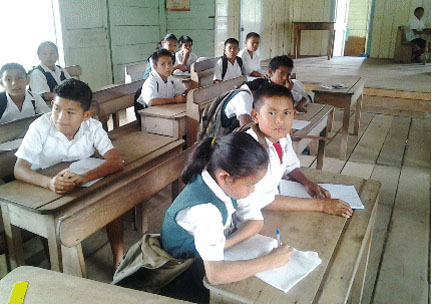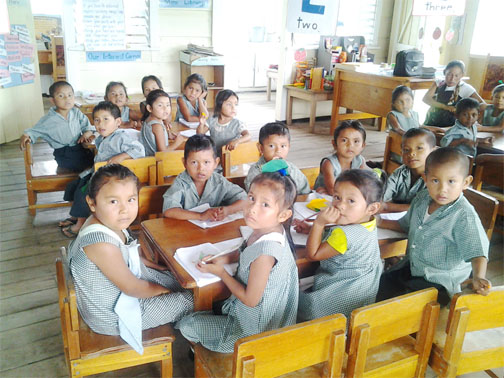On a foggy Wednesday morning as she washed clothes in the cold, dark water of the Kako River, a woman related that she once took a young relative to the city and when it was time to bathe, the girl asked where the river was so that they take a bath.
She laughed as she recounted the tale. If you have ever been to Kako, you would understand why. There are no bathrooms in Kako. There is no need for any. The Region Seven (Cuyuni/ Mazaruni) community sits on the bank of the Kako River and the cold, dark water remain, as yet, unspoiled. Here in this Akawaio Amerindian community of 700 persons, the river is not merely a river. It is the source of food and water for drinking and domestic use such as bathing and washing; it is the road that leads to the farmlands and to the airstrip at Kamarang and other communities in the rainforest.
Kako means Jasper in Akawaio – the reddish stone is found in the riverbed. The people, Akawaios, are fiercely protective of the river. Though close to the influences of the goldfields, it is yet untamed; people still live off the land, heading upriver in bark canoes, wood canoes and engine-powered boats to the mountain foot to their farms where they till the fertile soil. Some have guns but many shoot fish with bows and arrows or capture them in baskets.

students of the Kako
Primary School share
an umbrella as they
walk back to school
Children, ingeniously, use plastic bottles with a section of the bottom cut out to trap fish. The practice, ‘wai-white’ is simple: get a bottle, preferably one where the bottom tapers inwards, cut out that innermost section of the bottom, close the lid and place pieces of cassava bread or grated coconut meal in the bottle and leave it at the bottom of the river for several minutes. Then dive and bring it up. Fish are usually trapped in the bottle.
Kako is like that: wild, beautiful, independent, unspoiled and fierce. Upriver, are isolated settlements where families survive off the land; they have minimal contact with the outside world. Several times a year, they venture as far as Kako to sell cassava bread and the traditional beverage, casak, to get necessities like salt and matches. Then it is back upriver paddling more than a day to get back home, not to be seen again until months later. They speak Akawaio and little English with the older persons knowing almost no English.
Sitting silently on a ridge is a house with its thatched roof, walls of leaves on a clearing of white sand; it seemed like a step back into the past. No one was home. Far below the ridge – accessible only by stairs carved out of the gray and white sand and from which, on a clear day, one can see Mount Roraima in the distance – the dark, pristine water of the Kako River flows silently.
From the ridge, the forest stretches unbroken into the distance to the sharply rising cliffs of flat-topped mountain, Tepuis or ‘House of the Gods’ as an Amerindian tribe in Venezuela says.
In the village, most residents know English but prefer to speak Akawaio. Their homes are now being built of wood and zinc with the village council assisting financially in their construction; five families last year and five this year until all have benefited.
In the small wooden, weather-beaten school, children wrote their exams, out of the 151 registered students, on average, about 10 stay away. Kathleen Andrews, the headmistress said it is a challenge to get relevant materials for the curriculum to the remote community but they make do with what they have. It is difficult to get help too when things go wrong. In December, solar panels with five heavy-duty batteries were installed at the school so that they could get power. The brand-new system has not worked for the term. Despite complaints, there has not been a solution as yet, Andrews said. “They advised me to use local technicians. We call them but it too complicated for them,” she said.
Residents engage in small scale artisanal mining but say that this is done downriver. “Most of our boys go to other places where they have these mines where they [get paid] for work,” said Toshao Mario Hastings. The majority also work their farms. But jobs are needed. “Mining brings fast money even though it is dangerous,” said Hastings.
It is mining that caused the villagers to show their determination to defend their land when it was disclosed that a dredge was heading upriver. They fear greatly that their only source of drinking water, the Kako River, will be contaminated just like the silt-laden, discoloured Mazaruni River. The residents blocked the dredge three times but court action eventually saw the dredge being allowed to move upstream where it is working. The residents are fighting to keep any more dredges from moving upstream and even took the complaints to a United Nations body which expressed concern. “We know that this is our last refuge,” said Hastings.
There is one satellite television system in the village, which is owned by the pastor. Only one church, the Seventh Day Adventist denomination, is present in the community. There are three shops and no alcohol is sold in the community though persons buy from other communities and take to the village. Items are expensive here: a small bottle of water costs $500, while a 12 oz Coke is over $700.
Coconut trees are scattered throughout the village and when tangerines are in season, the tangy fruit are left to waste because they are plentiful.

a bark boat on the Kako River
The village began with three families: the Hastingses, the Kramers and the Williamses, who, like many others in Amerindian communities across the country, began to settle in one place as schools were opened and other services offered. Most of the villagers belong to one of these families.
Abel Kramer, 76, the Toshao from 1969 to 1982 still has sharp memories of when the village was established. He recalled that this began in 1957 when discussions began on moving from an old village across the river to the present site. “They put up houses for old people,” he said, adding that the church was used as a school and the community was built up little by little as more people came from their scattered settlements and established homes in the village. For Guyana’s independence in 1966, they built a benab to mark the occasion. Two years later, Kramer was elected Toshao taking over from his brother.
By this time, he had married Maxine, who is now 72, and together they had nine children. Maxine said her husband did not accept the bride arranged for him and chose her instead.
Nearby lives Alfred Kramer, age unknown and his wife Ellen, age unknown but it is estimated that she is 80 or thereabouts while he is around 90 years old. They are known throughout the village because they do everything together: go to the river, go fishing, go to the farm, to church and other places. They go about, stooped and very small, walking slowly. They are blessed with strength, they said, because they care for each other. “Once you care yourself, each other, you will live to see many years,” they said. Laughing is good too, they advised.
In Kako, far from anywhere, it seems that a peaceful way of life is possible. In the middle of the rainforest, there is a meadow, several acres wide, called the ‘savannah’ by residents and ringed by trees and the mountains, it is silent and peaceful. A path lined with wildflowers leads to the savannah. There are a few houses on the edges of the natural clearing.
From there, the river is hidden but you can clearly see Karawuta Mountain, sometimes shrouded in mist and other times in leis of clouds; it looks down on the village from afar. It is also called the ‘Angry One’ because when you point to it, it rains heavily. True story: We pointed. It rained.

Like with the river, taking a shower in the rain or swishing through fog and drizzle is possible in Kako. It remains relatively pure, so far.


Kako last week





his wife Maxine Kramer,
72, outside their home
at Kako last week.





